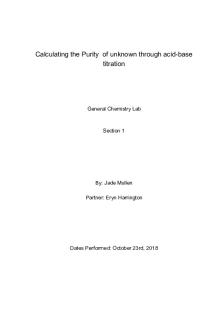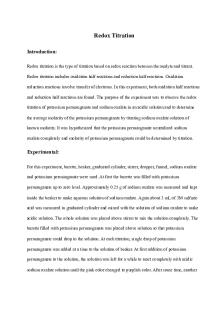LAB1 - Titration Final Lab report PDF

| Title | LAB1 - Titration Final Lab report |
|---|---|
| Author | MATHEW ANDREW HERNANDEZ |
| Course | General Chemistry (Laboratory) |
| Institution | Mapua University |
| Pages | 8 |
| File Size | 135.4 KB |
| File Type | |
| Total Downloads | 93 |
| Total Views | 140 |
Summary
Titration Final Lab report ...
Description
Experiment No. 1 Vinegar Analysis
DELOS REYES, JULIANNE MIKHAELLA C.
BMIE-1
CM011L - E01 Group No. 4
August 29, 2019 September. 5, 2019
E.S. ESPIRITU Professor
GRADE: PDS: Cover: Objectives: Report Sheet: Discussion & Conclusion:
EXPERIMENT NO.1 VINEGAR ANALYSIS
OBJECTIVES: The objective of this experiment is: 1. To identify the percent by mass of the acetic acid that is found in vinegar.
Laboratory Questions & Answers 1. A 20-mL volume of previously boiled, deionized water is added to the Erlenmeyer flask to prepare the sample for titration. Explain why this volume is not critical to the analysis. - Volume of water is uncritical because it does not affect the number balance of hydronium and hydroxide ions. It is only there t to make the endpoint reading easier. 2. Previously boiled, deionized water is unavailable. In a hurry to pursue the analysis, deionized water (not boiled) is added. How does this attempt to expedite the analysis affect the reported percent acetic acid in vinegar; too high; too low, or unaffected? Explain. - The percent by mass of acetic acid will be too low because there is still an acetic acid in water. 3. The 20-mL of water added to the Erlenmeyer flask is to be previously boiled, deionized water. Since water does absorb CO2 dissolved in water causes it to be slightly acidic, will the use of deionized water that has not been previously boiled cause the mass of acetic acid in the vinegar to be calculated as too high or too low? Explain. - Acetic acid in vinegar is calculated by the volumetric titration of acetic acid with the standardized NaOH solution. When the atmospheric carbon dioxide is absorbed by the deionized water used, it would react with water and make the formation of carbon dioxide. If the deionized water is contaminated with carbonic acid, it would result in the consumption of a higher amount of NaOH for neutralization. Therefore, the amount of acetic acid determined would be too high than it should be. 4. a.) In determining the percent acetic acid in vinegar, the mass of each vinegar sample is measured rather than the volume. Explain. -
The vinegar’s mass is gathered than the volume because acetic acid is defined as 5% of vinegar sample. With this, we can now calculate the mass in grams.
b.) If the vinegar were measured volumetrically (e.g., a pipet), what additional piece of data would be needed to complete the calculations for the experiment? - If the vinegar was measured volumetrically with the use of a pipet, its density would be needed to complete the calculations for the experiment. With the use of density, it would allow us to convert from grams to mL in an accurate way. 5. The buret is filled with the NaOH titrant and the initial volume reading is immediately recorded without waiting the recommended 10-15 seconds. However, in Part B.1, the 10-15 second time lapse does occur before the reading is made. Does this technique error in result in an increase, a decrease, or have no effect on the reported percent acetic acid in the vinegar? Explain.
-
This technique increases the given acetic acid in the vinegar. It should have a waiting period of 10-15 seconds before recording the initial volume of the buret. If its timed rightly, it would have accurately found the difference between the two measurements, which is the NaOH used.
6. The endpoint of the titration is overshot! Does this technique error result in increase, a decrease, or have no effect on the reported percent acetic acid in vinegar? Explain -
This technique error increases the reported amount of percent acetic acid in the vinegar. The endpoint of the titration was overdone because there is more base than there should have been if the titration was done correctly. Now, because there was an increase in the amount of base, there must be an increase in the amount of acid to neutralize the extra base. This attempt at neutralization results in a higher recorded percent acetic acid in the vinegar.
7. The wall of the flask is periodically rinsed with the previously boiled, deionized water from the wash bottle. Does this titrimetric technique result in increase, a decrease, or have no effect on the reported percent acetic acid in vinegar? Explain. -
This will has no effect on the percent of acetic acid in the vinegar because deionized water doesn’t affect the number balance of H+ hydronium ions or OHhydroxide ions. This is done just to make the endpoint reading easier.
8. A drop of NaOH titrant dispensed from the buret, adheres to the wall of the Erlenmeyer flask but is not washed into the vinegar with the bottle. Does this error technique result in the reported percent of acetic acid being too high, too low, or unaffected? Explain. - The amount of moles of NaOH would be equal to the amount of moles of acetic acid. Since there's more NaOH then necessary the found percentage of acetic acid is higher.
CALCULATIONS A. Trial 1 Mass of flask (g) = 130.26 grams Mass of flask + vinegar (g) = 130. 26 grams (flask) + 4.71 grams (vinegar) = 134.97 grams Buret reading of NaOH, initial (mL) = 0 mL Buret reading of NaOH, final (mL) = 33.4 mL Volume of NaOH used (mL) = 33.4 mL Moles of NaOH added=1 mole of NaOH =
3.5738 x 10−3
1. Molar Concentration Molar concentration = Molar concentration=
moles of solute Liters of solution 3.5738 x 10−3 0.0334 L
= 0.1070 m/L
2. Percent by mass mass of solute x 100 mass of solvent Mass of CH3COOH in vinegar = 0.214428 grams 0.214428 grams Percent by mass= x 100=4.55 % 4.71 grams B. Trial 2 Mass of flask (g) = 130.14 grams Mass of flask + vinegar (g) = 130. 14 grams (flask) + 4.04 grams (vinegar) = 134.81 grams Buret reading of NaOH, initial (mL) = 0 mL Buret reading of NaOH, final (mL) = 31.9 mL Volume of NaOH used (mL) = 31. 9mL Percent by mass =
Moles of NaOH added=3.4133 x 10 1. Molar Concentration
Molar concentration=
−3
3.4133 x 10−3 0.0319
= 0.1070 mL
2. Percent by mass Mass of CH3COOH in vinegar = 0. 204798 grams
Percent bymass=
0.204798 grams x 100=5.07 % 4.71 grams
C. Trial 3 Mass of flask (g) = 130.14 grams Mass of flask + vinegar (g) = 130.03 grams (flask) + 4.70 grams (vinegar) = 134. 73 grams Buret reading of NaOH, initial (mL) = 0 mL Buret reading of NaOH, final (mL) = 33 mL Volume of NaOH used (mL) = 33 mL −3
Moles of NaOH added=3.531 x 10 1. Molar concentration
Molar concentration=
3.531 x 10−3 0.033
= 0.1070 mL
2. Percent by mass Mass of CH3COOH in vinegar = 0.21186 0.21186 grams Percent by mass= x 100 = 4.51 % 4.71 grams 3. Average percent by mass of CH3COOH in vinegar 4.55 %+5.07 %+ 4.51% = 3 = 4.53 %
CONCLUSION Vinegar is a sour liquid containing acetic acid and water. The Acetic acid (CH3COOH) is the source of the sourness in vinegar and it is considered as a weak acid. In this experiment, titration method is used to calculate and determine the percent mass of acetic acid. Three trials have been undergone in this experiment. To get the percent mass, the molarity is calculated by dividing the mole of NaOH over the volume of NaOH in liters. The mole of NaOH and acetic acid is the same since it is neutralized in the solution. To get the percent by mass, divide the mass of acetic acid over the mass of the solvent (vinegar) then multiply to 100%. To calculate the average percent by mas, the sum of the percent by mass of the 3 trials then divide 3. As a result, in this experiment, the group discovered that there is a 4.53 % of acetic acid in vinegar, it is close to the theoretical percentage but due to some errors the group did not reach it.
RECOMMENDATION In this experiment, the group discovered that there is 4.53 % acetic acid in vinegar. Due to some errors, the group did not reach the theoretical percentage. So with this, there are some recommendations for the future groups so mistakes would not happen again. Firstly, be more careful in opening the turn handle of the pipet so that over tritiation would not occur in the solution. Second, organize the data in a clean sheet of paper to avoid any mix up in the calculations. Lastly, be more patient so that over titration would not happen....
Similar Free PDFs

Lab1 - Lab Report
- 1 Pages

Lab1 - Lab Report
- 27 Pages

Titration Worksheet - Lab Report
- 2 Pages

Lab Report titration curve
- 7 Pages

Back titration - chem lab report
- 2 Pages

Acid base titration lab report
- 5 Pages

Acid-Base Titration Lab Report
- 7 Pages

Lab1 - Lab
- 9 Pages

lab1 Report- Reflexes
- 5 Pages
Popular Institutions
- Tinajero National High School - Annex
- Politeknik Caltex Riau
- Yokohama City University
- SGT University
- University of Al-Qadisiyah
- Divine Word College of Vigan
- Techniek College Rotterdam
- Universidade de Santiago
- Universiti Teknologi MARA Cawangan Johor Kampus Pasir Gudang
- Poltekkes Kemenkes Yogyakarta
- Baguio City National High School
- Colegio san marcos
- preparatoria uno
- Centro de Bachillerato Tecnológico Industrial y de Servicios No. 107
- Dalian Maritime University
- Quang Trung Secondary School
- Colegio Tecnológico en Informática
- Corporación Regional de Educación Superior
- Grupo CEDVA
- Dar Al Uloom University
- Centro de Estudios Preuniversitarios de la Universidad Nacional de Ingeniería
- 上智大学
- Aakash International School, Nuna Majara
- San Felipe Neri Catholic School
- Kang Chiao International School - New Taipei City
- Misamis Occidental National High School
- Institución Educativa Escuela Normal Juan Ladrilleros
- Kolehiyo ng Pantukan
- Batanes State College
- Instituto Continental
- Sekolah Menengah Kejuruan Kesehatan Kaltara (Tarakan)
- Colegio de La Inmaculada Concepcion - Cebu






